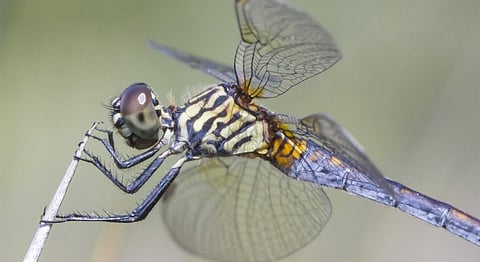
- #HGCREATORS
- #HGEXPLORE
- #HGVOICES
- #HGSHOP
- CAREERS
- ABOUT US
- CONTACT US

As painful as this heat wave might be for us, there’s no denying how many creatures find solace in its sticky lap. The generic green Dragonfly for one, innocently called ‘Helicopter’ by children, is seen in unusual numbers around damp places during this time raising its bulbous eyes. But while it’s easy to find a link between an insect and a time of year, only an unusual mind might find a connection between dwarf galaxies and Dragonflies; yet that’s exactly what an Astronomy and Physics professor at Yale University did, and he has an entire coffee table book to show for it. However, the sequence of events might surprise some.
Astronomer and Photographer Pieter Van Dokkum’scoffee table table book ‘Dragonflies: Magnificent Creatures of Water, Air, and Land’ was released in March 2015, and it’s a one-of-a-kind complete photographic record of the entire dragonfly life cycle, right from underwater larvae through metamorphosis, hunting, mating, egg laying, and death as reported by The Daily Beast. It was in the process of doing this—he spent approximately 1000 hours at 50 locations photographing dragonflies over five or six years—that Dokkum was able to connect both his passions. In an interview with Smithsonian Magazine, Dokkum suggested that Dragonfly eyes are composed of 30,000 compound lenses that enable them to spot and capture prey with astounding accuracy.

While watching them hunt, it occurred to him that combining multiple lenses into a single telescopic instrument could reduce light interference and possibly improve his ability to find some celestial objects that are the hardest to see.
Using the knowledge from this inference, The Dragonfly Telephoto Array called M101 was constructed and set up in the New Mexico desert by Dokkum and his colleague, ultimately allowing them to view Dwarf Galaxies, something even the Hubble Telescope had never been able to capture before. Understandably, he was humbled by what dragonflies had taught him. “They have mastery of their environment that is unique in the animal kingdom: they can fly upside down, stop, and change direction in the blink of an eye, hover and suddenly accelerate to speeds of up to thirty miles per hour,” he told the Hartford Courant. It was about looking at nature from a different spectrum; from the immense horizon of the cosmos all the way over to his favourite Pond in Connecticut.
He explained his only wish, “I’ve never seen the largest dragonfly species. They live in Southeast Asia, and have wingspans of 6 inches or more. Also, there is a damselfly species in South America that is even larger, with a wingspan of 7.5 inches. It would be amazing to take photos of those giants.”
While we hope he finds his way to the giant winged creatures, scroll on to see a few of the stunning images from his book.












